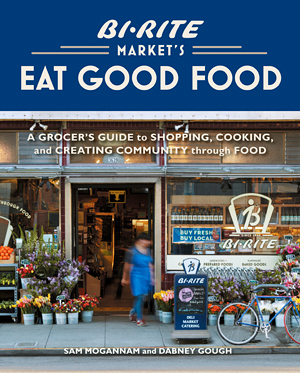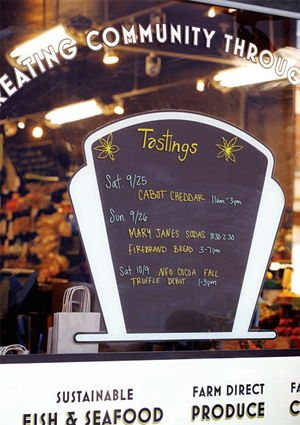 Some grocers offer recipes and coupons. Others offer recipes for a socioeconomic-savvy food system and a mean pear skillet cake.
Some grocers offer recipes and coupons. Others offer recipes for a socioeconomic-savvy food system and a mean pear skillet cake.
For the food shopper who thinks, the positively indispensable Bi-Rite Market’s Eat Good Food: A Grocer’s Guide to Shopping, Cooking, and Creating Community Through Food by Sam Mogannam and Dabney Gough (Ten Speed Press) released this month is the holy reference guide/blue book that clues consumers in to the real value of what’s on the grocery shelf. At a time when so much is being written about atrocities in our broken food system, consumers looking for sound, actionable advice on making grocery store purchasing decisions will appreciate this neatly compiled background check on everything from canned tuna to flour, fresh meat, fish and milk, and every manner of produce under the sun.
And note that this cannot be dismissed as a mere starter’s guide. As a veteran food nerd for decades, I thought that I knew a something about eating mindfully, ecologically, locally, and sustainably. But a primer on avoiding genetically modified organisms, and a full list of foods that are most commonly GMO? I am edified (sugar, milk and dairy, oils, corn and soybeans -- page 12). The pleasures of the texture of bronze die-cut pasta? I had no idea how this aspect of artisan pasta production can be essential for clinging sauce (page 37). And a list of all of the product acronyms on European foods that signify it is a product of protected origin (such as true, regionally-specific Champagne as opposed to methode champenoise) -- AO, DO, AOC, DOC, DOP, PDO, and IGT, page 47. And that’s just chapter one, people.
 Just as one pushes the cart down the grocery aisle, the uber-brainiac education rolls through every department, well-captured in France Ruffenach’s bright, busy photography that conveys what it feels like to shop in Bi-Rite on a sunny Saturday afternoon or at the 5pm dinner rush. Mogannam and Gough give faces to food throughout the book as well, introducing readers to the likes of his brother Raphael, grocery buyer; farmer for the store’s self-grown produce and produce buyer, Simon Richard; and a smattering of farmers that are enmeshed in Bi-Rite’s business and mission -- some, like Drakes Bay Family Farms, purely as retail partner; others, like Soul Food Farm, pet investments to help propel local and sustainable agriculture.
Just as one pushes the cart down the grocery aisle, the uber-brainiac education rolls through every department, well-captured in France Ruffenach’s bright, busy photography that conveys what it feels like to shop in Bi-Rite on a sunny Saturday afternoon or at the 5pm dinner rush. Mogannam and Gough give faces to food throughout the book as well, introducing readers to the likes of his brother Raphael, grocery buyer; farmer for the store’s self-grown produce and produce buyer, Simon Richard; and a smattering of farmers that are enmeshed in Bi-Rite’s business and mission -- some, like Drakes Bay Family Farms, purely as retail partner; others, like Soul Food Farm, pet investments to help propel local and sustainable agriculture.
The Eat Good Food shopping information stands alone as a necessity for any kitchen bookshelf. But the tome is also comprised of recipes from the Bi-Rite deli and beyond which, while well written to induce drool and craving, they feel awkwardly placed and difficult to find plunked at the end of each chapter. As a frequent Bi-Rite shopper, I was excited to finally crack the code on their addictive Mujadareh (see recipe below), and their heavenly and rich deli counter summer staple, Sergio’s Gazpacho. Even Delfina’s spaghetti makes a cameo, simple and delicious and part of the book’s neighborhood charm. And thumbing through I quickly found a new favorite, Mom’s Pear Skillet Cake from, you guessed it, Sam’s mother, which yields results that far outshine the effort, and is the perfect thing to be doing with pears right now.